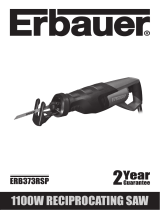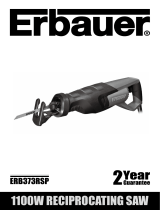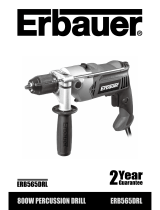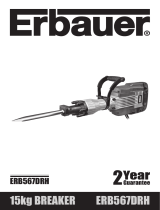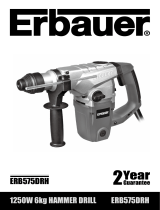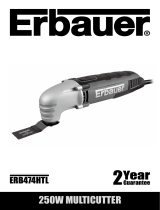Page is loading ...

4MM PLANER
ERB379PLN

4MM PLANER
Original Instructions
(Version 2.0)

4MM PLANER
GUARANTEE
This product carries a 2 year guarantee. If your product develops a fault within this
period, you should in the rst instance contact the retailer where the item was purchased.
This guarantee specically excludes losses caused due to:
- Fair wear and tear
- Misuse or abuse
- Lack of routine maintenance
- Failure of consumable items (such as batteries)
- Accidental damage
- Cosmetic damage
- Failure to follow manufacturer’s guidelines
- Loss of use of the goods
This guarantee does not affect your statutory rights. This guarantee is only valid in the UK.
For further technical advice, spare parts or repair service (outside of guarantee) please con-
tact the customer helpline number on 0345 607 6380.
Congratulations on your purchase of a quality power tool from Erbauer (UK) Ltd. This
product should give you reliable service but for your peace of mind this
power tool does carry a 2 year guarantee, the terms of which are detailed below.
If this product develops a fault within the guarantee period contact your retailer.
Please retain this handbook in case you need to refer to safety, care or guarantee
information in the future.

4MM PLANER
GENERAL POWER TOOL SAFETY WARNINGS
Warning: Read all safety warnings and all instructions.
Failure to follow the warnings and instructions may result in
electric shock, re and/or serious injury.
Save all warnings and instructions for future reference.
The term “power tool” in the warnings refers to your electric (corded)
power tool or battery-operated (cordless) power tool.
1. Work area safety
a. Keep work area clean and well lit. Cluttered or dark areas
invite accidents.
b. Do not operate power tools in explosive atmospheres,
such as in the presence of ammable liquids, gases or dust.
Power tools create sparks which may ignite the dust or fumes.
c. Keep children and bystanders away while operating a
power tool. Distractions can cause you to lose control.
2. Electrical safety
a. Power tool plugs must match the outlet. Never modify the
plug in any way. Do not use any adapter plugs with earthed
(grounded) power tools. Unmodied plugs and matching outlets
will reduce risk of electric shock.
b. Avoid body contact with earthed or grounded surfaces,
such as pipes, radiators, ranges and refrigerators. There
is an increased risk of electric shock if your body is earthed or
grounded.
c. Do not expose power tools to rain or wet conditions. Water
entering a power tool will increase the risk of electric shock.
d. Do not abuse the cord. Never use the cord for carrying,
pulling or unplugging the power tool. Keep cord away from
heat, oil, sharp edges or moving parts. Damaged or entangled
cords increase the risk of electric shock.
e. When operating a power tool outdoors, use an extension
cord suitable for outdoor use. Use of a cord suitable for outdoor
use reduces the risk of electric shock.
f. If operating a power tool in a damp location is unavoidable,
use a residual current device (RCD) protected supply. Use of

4MM PLANER
an RCD reduces the risk of electric shock.
3. Personal safety
a. Stay alert, watch what you are doing and use common
sense when operating a power tool. Do not use a power tool
while you are tired or under the inuence of drugs, alcohol
or medication. A moment of inattention while operating power
tools may result in serious personal injury.
b. Use personal protective equipment. Always wear eye
protection. Protective equipment such as dust mask, non-skid
safety shoes, hard hat, or hearing protection used for appropriate
conditions will reduce personal injuries.
c. Prevent unintentional starting. Ensure the switch is in
the off-position before connecting to power source and/or
battery pack, picking up or carrying the tool. Carrying power
tools with your nger on the switch or energising power tools that
have the switch on invites accidents.
d. Remove any adjusting key or wrench before turning the
power tool on.
A wrench or a key left attached to a rotating part of the power tool
may result in personal injury.
e. Do not overreach. Keep proper footing and balance
at all times. This enables better control of the power tool in
unexpected situations.
f. Dress properly. Do not wear loose clothing or jewellery.
Keep your hair, clothing and gloves away from moving parts.
Loose clothes, jewellery or long hair can be caught in moving
parts.
g. If devices are provided for the connection of dust
extraction and collection facilities, ensure these are
connected and properly used. Use of dust collection can
reduce dust-related hazards.
4. Power tool use and care
a. Do not force the power tool. Use the correct power tool for
your application. The correct power tool will do the job better
and safer at the rate for which it was designed.
b. Do not use the power tool if the switch does not turn it on

4MM PLANER
and off. Any power tool that cannot be controlled with the switch
is dangerous and must be repaired.
c. Disconnect the plug from the power source and/or
the battery pack from the power tool before making any
adjustments, changing accessories, or storing power tools.
Such preventive safety measures reduce the risk of starting the
power tool accidentally.
d. Store idle power tools out of the reach of children and
do not allow persons unfamiliar with the power tool or
these instructions to operate the power tool. Power tools are
dangerous in the hands of untrained users.
e. Maintain power tools. Check for misalignment or binding
of moving parts, breakage of parts and any other condition
that may affect the power tool’s operation. If damaged,
have the power tool repaired before use. Many accidents are
caused by poorly maintained power tools.
f. Keep cutting tools sharp and clean. Properly maintained
cutting tools with sharp cutting edges are less likely to bind and
are easier to control.
g. Use the power tool, accessories and tool bits etc. in
accordance with these instructions, taking into account the
working conditions and the work to be performed. Use of
the power tool for operations different from those intended could
result in a hazardous situation.
5. Service
a. Have your power tool serviced by a qualied repair person
using only identical replacement parts. This will ensure that
the safety of the power tool is maintained.
b. If the replacement of the supply cord is necessary, this
has to be done by the manufacturer or his agent in order to
avoid a safety hazard.
ADDITIONAL SAFETY POINTS FOR YOUR PLANER
1. Wait for the cutter to stop before setting the tool down. An
exposed cutter may engage the surface leading to possible loss

4MM PLANER
of control and serious injury.
2. Hold the power tool by insulated gripping surfaces only,
because the cutter may contact its own cord. Cutting a “live”
wire may make exposed metal parts of the power tool “live” and
could give the operator an electric shock.
3. Use clamps or another practical way to secure and support
the workpiece to a stable platform. Holding the work by hand
or against your body leaves it unstable and may lead to loss of
control.
4. Always wear safety glasses or eye shields when using the
Planer Everyday eyeglasses have only impact-resistant
lenses; they are NOT safety glasses. Following this rule will
reduce the risk of serious personal injury.
5. Always wear hearing protection during extended periods
of operation. Following this rule will reduce the risk of serious
personal injury.
6. Keep your hands away from cutting area. Do not reach under
the material being cut because the nearness of the blade to your
hand is hidden from your sight.
7. Do not use dull or damaged blades. Bent blades can break
easily, or cause kickback.
8. Remove the plug from the socket before carrying out any
adjustment, servicing or maintenance.
9. Fully unwind cable drum extensions to avoid potential
overheating.
10. When an extension cable is required you must ensure it has
the correct ampere rating for your power tool and is in a safe
electrical condition.
11. Ensure your mains supply voltage is the same as indicated on
the rating plate.
12. Your tool is double insulated for additional protection against a
possible electrical insulation failure within the tool.
13. Always check walls, oors and ceilings to avoid hidden power
cables and pipes.
14. After long working period, external metal parts and accessories
could be hot.
15. Only withdraw the blade from the cut when the blade has been
stopped moving.
16. The pivoting blade foot must be held rmly against the material

4MM PLANER
being cut to reduce saw vibration, blade jumping and blade
breakage.
17. Before cutting, check the cutting line is free of nails, screws, etc.
18. If possible, ensure the work-piece is rmly clamped to prevent
movement.
Never stop the cutting blade by applying side pressure to the
blade.
19. Always wear a dust mask.
Warning: Some dust particles created by power sanding, sawing, grinding, drill
and other construction jobs contain chemicals known to cause cancer, birth
defects or other reproductive harm. Some examples of these chemicals are:
• Lead from lead-based paints.
• Crystalline silica from bricks and cement and other masonry products.
• Arsenic and chromium from chemically treated timber.
Your risk from these exposures varies, depending upon how often you do this type of work.
To reduce your exposure to these chemicals:
• Work in a well-ventilated area.
• Work with approved safety equipment, such as those dust masks that are specially
designed to lter microscopic particles.
VIBRATION
The European Physical Agents (Vibration) Directive has been brought in to help reduce
hand arm vibration syndrome injuries to power tool users. The directive requires power
tool manufacturers and suppliers to provide indicative vibration test results to enable users
to make informed decisions as to the period of time a power tool can be used safely on a
daily basis and the choice of tool.
Further Advice can be found at www.hse.gov.uk
Vibration total values (triax vector sum) determined according to EN 60745:
Vibration emission value a
h
= 4.29 m/s²
Uncertainty K = 1.5m/s²
The declared vibration emission value should be used as a minimum level and should be
used with the current guidance on vibration.
Calculating the actual period of the actual period off use can be difcult and the HSE
website has further information.
The declared vibration emission has been measured in accordance with a standardised
test stated above and may be used to compare one tool with another tool.
The declared vibration emission value may also be used in a preliminary assessment
of exposure.

4MM PLANER
Warning: The vibration emission value during actual use of the power tool can differ
from the declared value depending on the ways in which the tool is used dependant
on the following examples and other variations on how the tool is used:
How the tool is used and the materials being cut or drilled.
The tool being in good condition and well maintained
The use of the correct accessory for the tool and ensuring it is sharp and in good condition.
The tightness of the grip on the handles.
And the tool is being used as intended by its design and these instructions.
While working with this power tool, hand/arm vibrations occur. Adopt the correct
working practices in order to reduce the exposure to vibration.
This tool may cause hand-arm vibration syndrome if its use is not adequately
managed.
Warning: identify safety measures to protect the operator that are based on an
estimation of exposure in the actual conditions of use (taking account of all parts of
the operating cycle such as the times when the tool is switched off and when it is running
idle in addition to the trigger time).Note The use of other tools will reduce the users’ total
working period on this tool.
Helping to minimise your vibration exposure risk.
ALWAYS use sharp chisels, drills and blades
Maintain this tool in accordance with these instructions and keep well lubricated
(where appropriate)
Avoid using tools in temperatures of 10ºC or less
Plan your work schedule to spread any high vibration tool use across a number of days.
Health Surveillance
All employees should be part of an employer’s health surveillance scheme to help identity
any vibration related diseases at an early stage, prevent disease progression and help
employees stay in work.
Double insulation
The tool is double insulated. This means that all the external metal parts are
electrically insulated from the mains power supply. This is done by placing insulation
barriers between the electrical and mechanical components making it unnecessary for the
tool to be earthed.
Important note
Be sure the supply is the same as the voltage given on the rating plate. The tool is tted
with a two-core cable and plug.
Remove the mains plug from socket before carrying out, any adjustment or servicing.

4MM PLANER
SYMBOLS
To reduce the risk of injury, user must read instruction manual
Warning
Double insulation
Wear ear protection Wear eye protection Wear dust mask
Waste electrical products should not be disposed of with household waste.
Please recycle where facilities exist. Check with your Local Authority
or retailer for recycling advice.
yyWxx Manufacturing date code; Year of manufacturing (20yy) and week of
manufacturing (Wxx);

4MM PLANER
2
1
3
5
4
10
11
12
14
13
7
6
8
9

4MM PLANER
1. LOCK-OFF BUTTON
2. ON/OFF SWITCH
3. CUTTING DEPTH ADJUSTMENT KNOB
4. DRIVE BELT COVER
5. DUST EXHAUST OUTLET
6. DUST BAG
7. PARALLEL GUIDE
8. PARALLEL GUIDE CONNECTOR
9. REBATE GUIDE
10. LOCKING SCREWS
11. HEX KEY
12. SPANNER
13. DUST EXTRACTION ADAPTOR
14. NUT

4MM PLANER
Voltage 230-240V~50Hz
Power input 1050W
No load speed 15500/min
Max cutting width 82mm
Max cutting depth 4mm
Max rebating depth 14mm
Protection class
Weight
/II
3.7kg
NOISE INFORMATION
A weighted sound pressure: L
pA
: 96 dB (A) K
PA
=3.0 dB (A)
A weighted sound power: L
wA
: 107 dB (A) K
WA
=3.0 dB (A)
Wear ear protection when sound pressure is over 80dB(A)
ACCESSORIES
Parallel guide (with locking screw & nut) 1pc
Rebate guide 1pc
Dust bag 1pc
Spanner 1pc
Dust cover 1pc
Hex key 1pc
Spare blades 1set
TECHNICAL DATA

4MM PLANER
OPERATING INSTRUCTIONS
Note: Before using the tool, read the
instruction book carefully.
Intended Use
The machine is intended for planing of rmly
supported wooden materials, such as beams and
boards. It is also suitable for beveling edges and
rebating.
1. SAFETY ON/OFF SWITCH (See Fig.1)
The switch is locked off to prevent accidental
starting. Depress the lock off button then the on/off
switch and release the lock off button. The machine
is working now. To switch off, just release the on/
off switch.
Warning: Danger of kickback! Apply the
machine to the work piece only when switched
on.
2. CUTTING DEPTH ADJUSTMENT(See Fig.2)
The planing depth can be adjusted from 0mm
to 4mm. To adjust the depth, turn the knob until
the required depth setting aligns with the arrow
on housing.Turn clockwise to increase and anti-
clockwise to decrease cutting depth. Always work
from a rough cut to a nish cut. It is recommended
that test cuts be made in scrap wood after each
adjustment to make sure that desired amount of
wood is being removed by your planer.
Note: To protect blades during storage,
transporting, etc., set blade depth adjustment
to 0mm.
3. GENERAL PLANING OPERATION(See Fig.3)
Set the desired cutting depth. Position the front part
of the base plate at onto the work surface. Make
sure that the blades are not touching the workpiece.
Switch the machine on and push your planer
forward and it will start cutting. Always maintain all
of the base plate at on the work surface to prevent
the cutting blade jumping. Move the plane evenly
over the work surface.
Be careful to avoid hitting nails during operation. It
could nick, crack, or damage blades. We suggest
that you always keep an extra set of blades on hand
for replacement.
Fig. 1
Fig. 2
Fig. 3
Fig. 4
2
a
1
45
o
10
7
9
10
8
2
a
1
45
o
10
7
9
10
8
2
a
1
45
o
10
7
9
10
8
2
a
1
45
o
10
7
9
10
8

4MM PLANER
4. EDGE CHAMFERING (See Fig. 4, 5)
Caution: Always use both hands on the tool
for any operation. It assures to maintain control
and avoid the risk of serious personal injury. The
workpiece must always be properly supported and
clamped so that both hands will be free to control
the planer.
Using the V-groove (a) in the base plate you can
make a chamfer on the work piece edge. Guide the
planer along the edge and maintain a constant angle
and force to produce a good nish. You can control
the angle of the chamfer with your hands. Make a
test chamfer on a scrap piece of wood. Maintain
downward pressure to keep your planer at at the
beginning and the end of the work surface.
5. USING THE PARALLEL GUIDE (See Fig.6)
Insert the screw provided through the hole on the
support of parallel guide connector (8). Then turn
the screw into the nut on the housing. Fix the
parallel guide on the parallel guide connector (8)
with the screw and nut (14). Ensure the screws are
tightened securely.
Note: The parallel guide should be tted on left
of housing.
To adjust the parallel guide to required width of cut,
loosen the nut and slide the parallel guide to the
required position. Retighten the nut fully.
When making cuts using your parallel guide, the
guide should be held rmly against the edge of the
workpiece.
6. USING THE REBATE GUIDE (See Fig.7)
Insert the screw provided through the slot on the
rebate guide. Then turn the screw into the nut on
the housing.
The cut depth adjustment can be set from 0mm to
14mm.
To adjust the rebate guide to depth of cut, place the
planer on a at board, then loosen the screw and
slide the cut depth adjustment guide up and down
for required depth, then tighten the thumb screw
fully.
7. THE WIDTH AND DEPTH OF RABBET CUT(See
Fig.8)
The width of rabbet cut is adjustable by moving the
parallel guide. The depth of rabbet cut is determined
by moving the depth guide, and the number of
passes made along the workpiece.
2
a
1
45
o
10
7
9
10
8
2
a
1
45
o
10
7
9
10
8
2
a
1
45
o
10
7
9
10
8
10
7
14
Fig. 5
Fig. 6
Fig. 7
Fig. 8

4MM PLANER
8. USING THE DUST COLLECTION BAG(See
Fig.9)
Your planer is equipped with a dust bag for collection
of wood chips in the work area.
Make sure the zipper on the bag is fully closed. To t
the dust bag, simply insert the tube end of the bag
into the dust extraction outlet. Then switch on and
start planing.
CLEANING DUST EXHAUST OUTLET AND
EMPTYING THE DUST BAG (See Fig.10)
After using your planer for an extended period of
time or when planing wet green timber, chips may
build-up in the dust exhaust outlet and require
clearing. Chip build-up restricts air ow and causes
the motor to overheat. Turn off the planer and
remove the dust bag from the dust exhaust outlet.
Clean the chip and dust exhaust outlet of your
planer with a small piece of wood. Do not use your
hands or ngers. Unzip the dust bag and empty all
chips from it. Ensure collar is free from debris.
We recommend emptying the dust bag every 3-6
minutes.
Using the dust extraction adaptor
Your planer is equipped with a dust extraction
adaptor(13), which is designed for collecting dust
task. Connect the dust extraction adaptor into the
hose of a vacuum cleaner. First please turn on the
vacuum cleaner, then turn on the planer. If you stop
planing, rst turn off the planer, then turn off your
vacuum cleaner.
9. BLADE REPLACEMENT (SEE FIG.11, 12)
Note: The blades in your planer are replaceable.
Always replace blades in pairs. Do not attempt to
sharpen blades. If the blades become dull, replace
them. Blades are sharp, use extreme caution when
replacing blades.
Warning: Remove power cord from the
socket before carrying out any adjustments
or changing blades. Always put on gloves when
replacing blades.
Using the blade spanner provided loosen the three
installation screws approximately 1/2 rotation
anticlockwise.
Note: Do not over loosen the screws. If screws are
too loose, alignment of the new blade will not be
accurate.
Before removing old blades, take notice of the
10
7
14
10
7
14
10
7
14
10
7
14
Fig. 9
Fig. 10
Fig. 11
Fig. 12

4MM PLANER
10
7
14
10
7
14
10
7
14
Fig. 13
Fig. 14
Fig. 15
direction of cut as well as how the tapered edge of
the old blades are oriented. The tapered edge of the
new blades must be in the same orientation as the
original blades.
Using your nger press the safety cover down, then
using the tip of a spanner (or screwdriver) to push
blade out of the drum and then remove.
Note: If a blade cannot be pushed out of blade drum
easily after loosening screws, use a block of wood
to break the blade loose from the blade holder, with
a short sharp blow. Then push with a screwdriver to
remove the blades. If necessary, tap block of wood
sharply with a small hammer to break blades loose.
Clean any saw dust or wood chips from around the
blade area.
Slide new blade into the slot of the blade drum.
Use a spanner (or screwdriver) to push the blade
into the blade drum until it is centred into position.
Using the blade spanner, retighten the three blade
installing screws.
Repeat the above procedure to change the other
blade.
After blades are replaced, check that blades are
parallel and same surface as the rear base plate
with ruler. If not, you can adjust the blades with
hexagonal wrench provided. To adjust the blades,
rstly loosen the three screws on the blade holder.
Then turn clockwise the socket head screw, the
blade will be risen, turn anti-clockwise the socket
head screw, the blade will be lowered down. Finally
retighten the three screws fully.
10. DRIVE BELT REPLACEMENT
(See Fig.13, 14)
Warning:
1). Remove the plug from the socket before carrying
out any adjustment, servicing or maintenance.
2). The cutting blades will be turning and may
cause injury.
3). Always put on gloves when operation.
Loosen the screw and remove the belt cover.
Remove the worn drive belt from the large pulley
and the pinion and clean them. Lace the new
belt on the top of the pinion and turn it manually,
press it on the large pulley Make sure that the
drive belt runs exactly along the length grooves
of the pinion and the pulley. Replace the belt
cover. Install the cover screw and tighten fully.

4MM PLANER
11. CORRECT PLANER BLADE SETTING (See
Fig.15)
Your planing surface will end up rough and uneven,
unless the blade is set properly and securely.
The blade must be mounted so that the cutting edge
is absolutely level, that is, parallel to the surface of
the rear base. Below are some examples of proper
and improper settings.
(A) Front base (Moveable shoe)
(B) Rear base (Stationary shoe)
1) Correct setting
Although this side view cannot show it, the
edges of the blade run perfectly parallel to the
rear base surface.
2) Nicks in surface
Cause: one or both blades fails to have edge
parallel to rear base line.
3) Gouging at start
Cause: one or both blade edges fails to protrude
enough in relation to rear base line.
4) Gouging at end
Cause: one or both blade edges protrude too far
in relation to rear base line.
MAINTENANCE
Remove the plug from the socket before carrying
out any adjustment, servicing or maintenance.
Your power tool requires no additional lubrication or
maintenance. There are no user serviceable parts
in your power tool. Never use water or chemical
cleaners to clean your power tool. Wipe clean with
a dry cloth. Always store your power tool in a dry
place. Keep the motor ventilation slots clean. Keep
all working controls free of dust. Occasionally you
may see sparks through the ventilation slots. This is
normal and will not damage your power tool.
If the supply cord is damaged, it must be replaced
by the manufacturer, its service agent or similarly
qualied persons in order to avoid a hazard.
TROUBLESHOOTING
1. If your power tool does not start, check the plug
on the power supply rst.
2. If the planer cuts unevenly, check blade
adjustment, sharp, free, nicks or damage.
3. If a fault can not be rectied return the planer to
an authorized dealer for repair.

4MM PLANER
ENVIRONMENTAL PROTECTION
Waste electrical products should not be
disposed of with household waste. Please
recycle where facilities exist. Check with your
Local Authority or retailer for recycling advice. For
further information visit www.recycle-more.co.uk.

4MM PLANER
PLUG REPLACEMENT
(UK & IRELAND ONLY)
If you need to replace the tted plug then follow the
instructions below.
IMPORTANT
The wires in the mains lead are colored in
accordance with the following code:
BLUE =NEUTRAL
Brown = Live
As the colors of the wires in the mains lead of this
appliance may not correspond with the colored
markings identifying the terminals in your plug,
proceed as follows. The wire which is colored blue
must be connected to the terminal which is marked
with N. The wire which is colored brown must be
connected to the terminal which is marked with L.
Warning:
Never connect live or neutral wires to the earth
terminal of the plug. Only t an approved 13AMP
BS1363/A plug and the correct rated fuse.
Note: If a moulded plug is tted and has to be
removed take great care in disposing of the plug
and severed cable, it must be destroyed to prevent
engaging into a socket.
13 Amp fuse approved
to BS1362
Connect
Blue to N
(neutral)
Outer sleeve
rmly clamped
Brown L(live)
Cable grip
/


